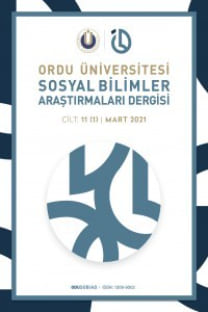Geri Kazanılmış Pamuklu Kumaş Özelinde Tekstil Heykele Güncel Yaklaşımlar
Tekstil sanatı, Lif Sanatı, Heykel, Yumuşak Heykel, Pamuklu Kumaş, Geri dönüşüm, Sürdürülebilirlik
Current Approaches to Textile Sculpture on Recycled Cotton Fabric
Textile Art, Fiber Art, Sculpture, Soft Sculpture, Cotton Fabric, Sustainability, Recycled,
___
- Referans1: Andre, M. (2020). L’art Du Pli, Les Nouveaux Cahiers de La Semaine, Maison, Parisienne, December, France
- Referans2:Avila, A. (2016).Simon Pheulpin Within The Folds, Les Editions, Ateliers Dart, France
- Referans3:Baizerman, S. (2004). California and The Fiber Art Revolution, Textile Society of America.9th Biennial Symposium, Oakland, California, October 7-9 Erişim Adresi: https://digitalcommons. unl.edu/cgi/viewcontent.cgi?article=1449&context=tsaconf
- Referans4:Barrett, T. (2015) Neden Bu Sanat ?, Hayalperest Yayınları, (Çev: Esra Ermert Tinaz), İstanbul
- Referans5:Beyoğlu, A . (2019). Sanatta Mekân Kurgusu Bağlamında Joseph Beuys Yapıtları. Yedi , (21) , 33-41. DOI: 10.17484/yedi.438007
- Referans6Deleuze, G. (2017). Fark ve Tekrar, (Cev: Burcu Yalım ve Emre Koyuncu),İstanbul: Norgunk Yayınevi.
- Referans7:Ersoy, N. (2000). Semboller ve yorumları (Bölüm I-II) (1. bs.). İstanbul: Zafer Matbaası.
- Referans8:Gaiger, J. ve WOOD, P.(2003). Art of the Twentieth Century: A Reader, Yale University Press Publications.
- Referans9:Gaiger, J. (2003). Frameworks for Modern Art, Singapore: Open University, Press.
- Referans10 Hemmings, J. (2012) The Textile Reader, England: Berg Publishers
- Referans11Koşar, S.T. (2016). Lif Sanatında Hacmin Etkilerine Farklı Yaklaşımlar, Yayınlanmamış Sanatta Yeterlik Tezi, Dokuz Eylül Üniversitesi Güzel Sanatlar Enstitüsü, İzmir.
- Referans12Koşar, S.T. (2017). Çağdaş Sanat Disiplinleri Arası Etkileşimlerde Lif Sanatı. idil, 6 (35), s.2035-2059
- Referans13Lunin, L., F.(2016) The Descriptive Challenges of Fiber Art , ideals.illinois.edu Erişim Adresi: https://www.ideals.illinois.edu/bitstream/handle/2142/7694/librarytrendsv38i4f_opt.pdf
- Referans14Meilach, D. Z. (1974). Soft Sculpture And Other Forms Of Art. New York: Crown Publisher
- Referans15Mitrofanova N.Yu. (2019). Modern Textile Art in A Search For New Forms, Meanings and Means Of Expressions. Bulletin of Vaganova Ballet Academy. 2019;(1):176-190. (In Russ.)
- Referans16Nolde, E. (2003) İlkel Sanat Üzerine, C Harrison ve P. Wood (Editörler). Sanat ve kuram. (Çev. Sabri Gürses). Birinci Baskı, Küre Yayınları, İstanbul. Referans17Parker R. (1984). The Subversive Stitch: Embroidery and the Making of the Feminine (1984; repr. New York, 2010)
- Referans18Sezer, A . (2020). Kandinsky’nin Biyomorfik Soyutlamaları. Uluslararası Kültürel ve Sosyal Araştırmalar Dergisi (UKSAD) , 6 (1) , 269-279. Retrieved from https://dergipark.org.tr/tr/pub/intjcss/issue/55225/737183
- Referans19Yarbaşı, Ş. (1983). Tekstil Malzemeleriyle Oluşturulan Sanat Objeleri, Yayınlanmamış Sanatta Yeterlik Tezi, Mimar Sinan Üniversitesi Sosyal Bilimler Enstitüsü, İstanbul.
- İnternet Kaynakları Referans20URL1: http://www.browngrotta.com/Pages/pheulpin.php. Erişim Tarihi: 21-12-2020
- Referans21URL2: https://souchaudartprojectlyondotcom.wordpress.com/2016/04/20/melanie-nitting/ Erişim Tarihi: 21-12-2020
- Referans22URL3: http://melanienitting.com/biographie/ Erişim Tarihi: 03-01-2021
- Referans23URL4: https://www.mrxstitch.com/karine-jollet/ Erişim Tarihi: 03-01-2021
- Referans24URL5:https://www.medinart.eu/works/karinejollet/#:~:text=Karine%20Jollet%20was%20born%20in,of%20things%20and%20their%20interior Erişim Tarihi: 03-01-2021
- Referans25URL6: https://www.medinart.eu/works/karine-jollet/ Erişim Tarihi: 03-01-2021
- Referans26URL7: http://artasiamerica.org/works/7259 Erişim Tarihi: 07-01-2021
- Referans27URL8:http://koreanartistproject.com/eng_artist.art?method=artistView&auth_reg_no=118&flag=artist&flag2=crit&flagsub=Y Erişim Tarihi: 07-01-2021
- Referans28URL9:http://koreanartistproject.com/eng_artist.art?method=artistView&auth_reg_no=118&flag=artist&flag2=crit&flagsub=Y Erişim Tarihi: 07-01-2021
- Referans29URL10: https://www.artsper.com/us/contemporary-artists/france/283/anne-valerie-dupond Erişim Tarihi: 11-01-2021
- Referans30URL11: https://www.galeriemondapart.com/anne-valrie-dupond. Erişim Tarihi: 11-01-2021
- Referans31URL12:http://www.fiberarthangzhou.com/Site_En/Artist/ArtistDetail.aspx?aid=23 Erişim Tarihi: 11-01-2021
- Referans32URL13:https://www.mutualart.com/Artwork/Staring-Out-into-the Infinite/4AEB5A62CB80995C Erişim Tarihi: 11-01-2021
- Referans33URL14: https://karenartmexico.wordpress.com/2012/11/06/miriam-medrez-_-zureindo-lo-que-los-ojos-no-alcanzan-a-ver-darning-what-the-eyes-cannot-see-_-at-ensenadas-centracearte/ Erişim Tarihi: 11-01-2021
- ISSN: 1309-9302
- Yayın Aralığı: Yılda 3 Sayı
- Başlangıç: 2010
- Yayıncı: -
Türkiye’de Eğitim Alanında Artırılmış Gerçeklikle İlgili Yapılan Tezlerin İncelenmesi
Türkiye’de Yüksek Teknoloji Ürün İhracatı ve İnovasyon İlişkisi Üzerine Ekonometrik Bir İnceleme
Canlılar Dünyasına Yolculuk Konu Alanına Yönelik Başarı Testi Geliştirme Çalışması
Ayça CİRİT GÜL, Zeki APAYDIN, Elif Omca ÇOBANOĞLU
Sosyal Bilgiler Öğretim Programındaki Değerlerin Sosyal Bilgiler Ders Kitaplarına Yansımaları
Demokrat Parti Döneminde Halk Eğitime Yönelik Bir Teşkilat ve Konya’daki Faaliyetleri: 4-K
Türkiye’de Tersine Lojistiğin Rolü
Türkiye'de Sürdürülebilirlik Raporlaması ve Kurumsal İtibar
Seçil DEREN VAN HET HOF, Sibel HOŞTUT
Halil İbrahim TURHAN, İsmail KURT
Toplumun Direnen Kaleleri ve Değişim Rüzgârları: Çikolata Filmi Örneğiyle
Laboratuvar Kan Gazı Cihazı Alternatiflerinin Bulanık VIKOR ve Bulanık EDAS ile Değerlendirilmesi
